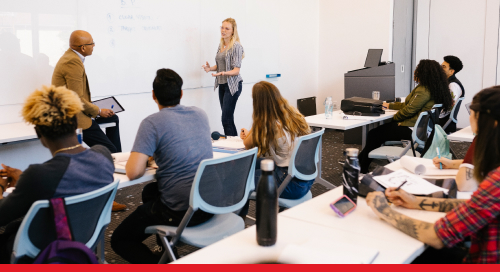Milestones: A Longitudinal View of Human Development
Check out this article that gives an inside look at a longitudinal view of human development
Published June 1, 2015
The McGraw-Hill Milestones video series is a powerful tool that allows students to experience life as it unfolds, from infancy to adolescence and beyond. This groundbreaking, longitudinal video series tracks the development of real children as they progress through the early stages of physical, social, and emotional development in their first few weeks, months, and years of life. Assignable and assessable within Connect Psychology, the Milestones video series also includes videos and interviews with adolescents and adults to reflect not only child development but development through the entire lifespan.
What was it like creating Milestones with your own daughter featured in the series? Were there moments in everyday life where you thought to yourself, "Oh, that would have been perfect for the video!" Did things happen spontaneously or did you have to coax answers and reactions out of Amalia? Do you have any funny bloopers or stories from the process?
Creating the Milestones videos was a lot of fun—certainly much more than I expected ahead of time. Prior to the actual filming, I would sit down with Art Kohn (who did the filming and editing) and we would develop a spreadsheet that had categories for ages, concepts, and ways we might capture that concept changing over time. Sometimes ideas would come from research and reading I was doing for my books. Other times Amalia would do something, or I would see other children do something, and that would give me an idea to use. Still other times we would have ages or domains of development we needed to fill in and I would wrack my brains for days trying to come up with an idea.
It was—unexpectedly for me—a very creative task. It wasn't always easy to come up with ideas, particularly when they involved children interacting in the real world rather than being tested in a laboratory-type situation. Once we had the ideas, we also had to actually get that on film, which was a challenging prospect. Usually we would have a plan of attack – in that we would have a series of 4-5 concepts we wanted to capture. I'd gather whatever props were needed, and we would cross our fingers and hope for the best. Kids being what they are, they would sometimes cooperate, and sometimes refuse. Generally, we would just keep the camera rolling, because you never knew when something of interest might happen.
It would have been fun even if my daughter had not been one of the Milestones kids, but I think the fact that she was in many of the videos was icing on the cake for me. I certainly felt that it allowed me more latitude in asking her to do things that I might not have done with other children. For example, when filming the segment on taste perception, I didn't have any qualms about giving her droppers of her vitamins – which I knew she hated – in order to get her facial expression. I would not have felt comfortable doing that with another person's child.
We did have bloopers. For example, one time we decided to try a replication of Mischel's delay of gratification task. I had a box of chocolates shaped like shoes that Amalia had been obsessed with – they were the conjunction of two things she was very fond of. We sat her at her play table and I put a chocolate down in front of her and told her that if she did not eat the first chocolate and waited, when I came back she could have two. We set the camera up to film her and went into the other room. We came back a few minutes later and she was sitting quietly, hands folded in front of her, the chocolate untouched. We went in to the other room again and waited and waited and still she did not eat the chocolate [[the video was intended to capture pre-milestone behavior, meaning that Amalia should not have been able to delay gratification]. Finally, I went in and tried to break her. I chatted with her a bit about how good the chocolate would taste and how pretty it was and asked her to smell it and we talked about how delicious it smelled. I left again, and still she would not eat it. We finally gave up. Amalia - by the way - got both her chocolates and was thrilled with filming that day.
Did you ever watch the videos with Amalia? What does Amalia think about being part of the project?
I have shown Amalia the videos. I would characterize her response as unimpressed. My own mother, on the other hand, nearly exploded, and according to my father, watched the videos I sent her over and over again.
I also pointed out the photos on the back cover of Child and the inside of A Child's World to Amalia. Her comment was "Those pictures are pretty small and you can't see me very good. Also, I think I should have been on the front cover."
As a professor of Psychology, what do you think is the value that Milestones brings to today's Psychology classroom? How do you think Milestones helps students experience Psychology and understand course concepts as they apply to real human lives?
One of the things that always bothered me about many of the videos available for developmental psychology courses is that while we generally spend a lot of time talking about the importance of developmental research design and the distinctions between cross-sectional and longitudinal research, we then illustrate all concepts using only cross-sectional video clips. So one of my favorite aspects of the Milestones videos are their longitudinal nature. I think being able to see one child mature and change over time brings the concepts alive in ways that cross- sectional video cannot and highlights the differences in approach. Now – cross-sectional videos are still important, particularly for older ages where the pace of change slows and instead of waiting 6 months for the next video in the series you might have to wait decades, but the ability to use both kinds of videos is a key feature for me.
I also think that it's clear that these are real children, in real families, and interacting in natural environments. I think that shows students that the things they're learning about aren't just academic busywork and random facts, but rather, that they infuse our daily lives and are all around us. Because psychology is all around us, and once you know what to look for, you see it everywhere.
Do you have any tips for instructors looking to incorporate Milestones into their classroom as either part of the homework or the lecture component of their course?
I am a huge fan of using short video clips in class. I remember being in college, and even when I had professors that I really liked, it would often be hard to stay focused on the material, especially for longer classes. So, I like to use videos to illustrate concepts, but also as a tool to break up lectures into smaller bites. I try to incorporate a video about every 15 minutes or so, and generally only use videos that are about 2-4 minutes in length. The Milestones are perfect for this – in fact, that's in part why they are the length they are.
With respect to assigning Milestones as homework, I generally do so after first watching the video together in class. I like to frame the videos for the students, watch it with them, and then reinforce the information in the homework. There are also questions – 3 per video – that can be used to assess the students. I think that helps motivate them to attend to them more closely rather than, say, checking Twitter or Instagram as the video plays.


